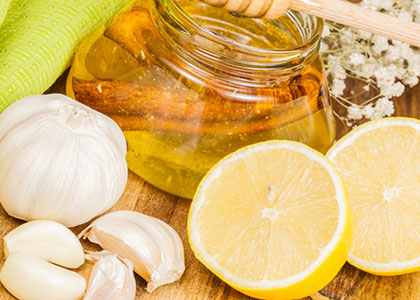
6 Simple Immune-Boosting Foods
By Isabel Smith, MS, RD, CDN
There are plenty of viruses and colds going around but instead of always looking to supplements, medications and prescriptions from your doctor to help you feel better, it’s time to start looking right in your kitchen. These six foods offer simple solutions to keep you healthy this season thanks to their immune-boosting and bacteria-fighting properties. You might not even have to step out to the store to start consuming them, they are probably already right your pantry or fridge.
1. Honey
Although honey is sugar, and cutting back on sugar is advantageous for blood sugar control and weight maintenance, if there is any sugar you’re using regularly (like in tea), it should be honey. Honey is well known for it’s bacteria-fighting properties and nutrients including hydrogen peroxide that can help to ward off colds and other bugs.
Tips for buying honey: The darker the color, the more nutrients it contains, so choose a variety like Buckwheat Honey that’s darker in color for more antioxidants and illness-fighting properties.
How to use honey:
- As a replacement for regular sugar, agave, or maple syrup in recipes and baking
- In tea for sweetener
- As a replacement for artificial sweeteners
2. Garlic
Garlic is surely referred to as a superfood by many as it contains powerful nutrients that have been found to be cancer-preventive and bacteria-fighting. One of the main nutrients in garlic, allicin, has been found to contain properties that help to fight infections like yeast infections and also has anti-viral properties that may help to fight the common cold and flu viruses.
How to use garlic:
- For allicin to be active, the garlic must be cut or crushed, then let it sit for 5-10 minutes to ensure that the nutrient is active
- Once the garlic is chopped or crushed and has sat for a few minutes, it can be consumed either raw or cooked.
- If consuming raw, you can swallow the small pieces like a pill; if cooking it, enjoy it in this Garlic Cauliflower Mash
3. Lemons
Lemons and lemon peels contain nutrients such as coumarin and tetrazine that have been found to contain bacteria-fighting properties. Lemons are also a rich source of vitamin C that can help to fight colds and viruses.
How to use lemons:
- Start your day with warm lemon water — find out why it’s one of the healthiest ways to begin your morning
- In juices and smoothies
- Use the peel (also known as the zest) for flavoring
- Use over fish or other healthy animal-protein for flavoring
- Use simply in hot water for a digestion-boosting beverage
4. Naturally Fermented Food
Naturally fermented foods like dairy-free kefirs and yogurts (coconut, almond, hemp or other type) contain probiotics, also known as “healthy bacteria.” The fermentation of foods aids digestion by partially breaking down the food components such as the lactose in yogurt hence why some people can tolerate yogurt but do not feel well after drinking milk or sour dough instead of regular baker’s bread. The main by-product lactic acid not only keeps foods in a state of preservation but also promotes the growth of healthy flora throughout the intestine.
How to consume more probiotic-rich foods:
- Kimchi or sauerkraut (choose the unpasteurized variety)
- Dairy-free yogurt (coconut, almond, hemp-milk or others)
- Kombucha
- Dairy-free kefir (coconut, almond, hemp-milk or others)
- Miso soup
- Sour pickles
- Tempeh
5. Bone Broth
For anyone who isn’t vegan or vegetarian, bone broth is a popular go-to when it comes to immune-boosting and cold and flu-fighting properties. Bone broth contains nutrients that can help to heal the gut, making the immune system stronger and less susceptible to viruses and diseases. Especially when using grass-fed, organically raised bones as the base of the broth, there is more arginine and glycine which are two important amino acids that can help to fight illness. If you’re new to bone broth, you can learn more about it.
How to use bone broth:
- You can make it yourself with this simple recipe
6. Nuts: Cashew, Pistachios & Almonds
Lastly, nuts such as cashews, pistachios and almonds are a source of zinc. Zinc plays an important role in immunity and function of white blood cells that are key for fighting infection and overall for boosting immunity.
How to use zinc-rich nuts:
- On oatmeal or hot cereal
- In smoothies
- On salad or other entrees